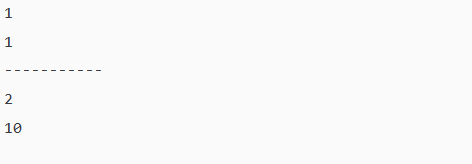一。Integer包装类
Integer的最有效使用效率取值范围为-128到127,最大取值到最小取值为-2147483648到2147483647(-231至 230)
- 示例1
public static void main(String[] args) {
Integer i1 = -128;
Integer i2 = -128;
Integer i3 = 127;
Integer i4 = 127;
System.out.println(i1==i2);
System.out.println(i3==i4);
}

2.示例2
public static void main(String[] args) {
Integer i1 = -129;
Integer i2 = -129;
Integer i3 = 128;
Integer i4 = 128;
System.out.println(i1==i2);
System.out.println(i3==i4);
}

原因
public static Integer valueOf(int i) {
if(i >= -128 && i <= IntegerCache.high)
return IntegerCache.cache[i + 128];
else
return new Integer(i);
}
其中IntegerCache类的实现为:
private static class IntegerCache {
static final int high;
static final Integer cache[];
static {
final int low = -128;
// high value may be configured by property
int h = 127;
if (integerCacheHighPropValue != null) {
// Use Long.decode here to avoid invoking methods that
// require Integer's autoboxing cache to be initialized
int i = Long.decode(integerCacheHighPropValue).intValue();
i = Math.max(i, 127);
// Maximum array size is Integer.MAX_VALUE
h = Math.min(i, Integer.MAX_VALUE - -low);
}
high = h;
cache = new Integer[(high - low) + 1];
int j = low;
for(int k = 0; k < cache.length; k++)
cache[k] = new Integer(j++);
}
private IntegerCache() {}
}
总结
从这两段代码可以看出,在通过valueOf方法创建Integer对象的时候,如果数值在[-128,127]之间,便返
回指向IntegerCache.cache中已经存在的对象的引用;否则创建一个新的Integer对象
- 示例3
public static void main(String[] args) {
System.out.println("最大取值:" + Integer.MAX_VALUE);
System.out.println("最小取值:" + Integer.MIN_VALUE);
}

1.超出范围会怎么样
public static void main(String[] args) {
System.out.println(1);
// toBinaryString 返回int变量的二进制表示的字符串
System.out.println(Integer.toBinaryString(1));
System.out.println("-----------");
//左移运算<<,将二进制向左移动一位,即数值乘以2。
System.out.println(1 << 1);
System.out.println(Integer.toBinaryString(1 << 1));
}

public static void main(String[] args) {
//已知Integer的二进制是32位,那么当1左移31位时达到最高位,即Integer的最小值
System.out.println(Integer.toBinaryString(1 << 31));
System.out.println(1 << 31);
System.out.println(Integer.MIN_VALUE);
}

继续左移动一位
public static void main(String[] args) {
//继续左移动1位
System.out.println(Integer.toBinaryString(1 << 32));
System.out.println(1 << 32);
}

总结
当范围达到最大范围时,在高位产生溢出,溢出时返回最低位,从最低位重新开始。可以理解为一个循环。最高位的下一位就是最低位,即第31位之后是第0为,1现在在第31位上,再向左移1位,回到第0位上,即回到十进制的1。同理向下溢出也是一样的。
二。Double包装类
- 示例1
public class Main {
public static void main(String[] args) {
Double i1 = 100.0;
Double i2 = 100.0;
Double i3 = 200.0;
Double i4 = 200.0;
System.out.println(i1==i2);
System.out.println(i3==i4);
}
}
结果:

总结; 在某个范围内的整型数值的个数是有限的,而浮点数却不是。
版权声明:本文为weixin_49076592原创文章,遵循 CC 4.0 BY-SA 版权协议,转载请附上原文出处链接和本声明。